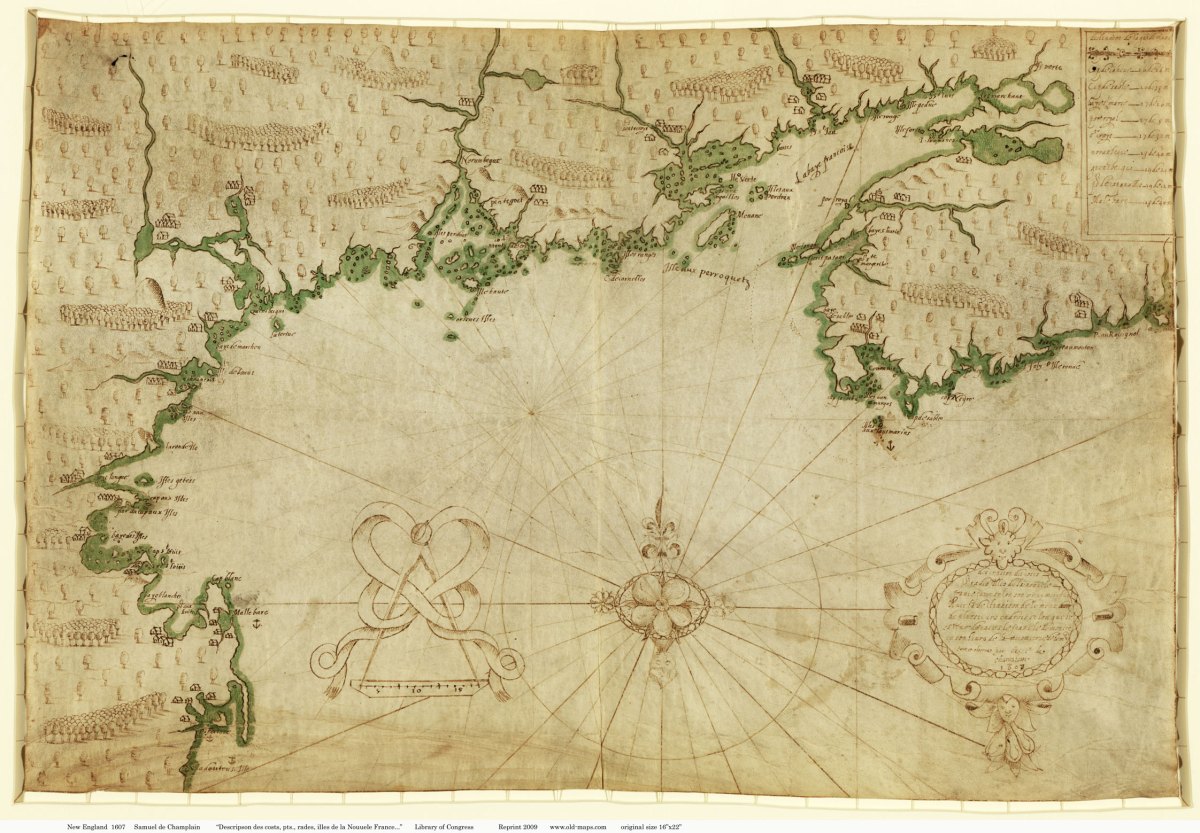While the artisans were busy building the French settlement at St. Croix, Pierre Dugua sent Samuel de Champlain with 12 sailors and 2 local guides to explore along the coast of what is now Maine. It would be the first deep European penetration into this region.
They set out on September 2, 1604, and heading down the coast they “passed a great number of islands, sand-banks, shoals, and rocks” and within a few days sighted Mount Desert Island, which Champlain named for the stone mountain peaks, that were bare of trees. He described Mt. Desert Island as: “about four or five leagues in length, of which we were almost lost on a little rock, level with the surface of the water, which made a hole in our pinnace close to the keel. The distance from this island to the mainland on the north is not a hundred paces. It is very high and cleft in places, giving it the appearance of the sea of seven or eight mountains one alongside the other. The tops of them are bare of trees because there is nothing there but rocks. The woods consist only of pines, firs, and birches. I named it Mount Desert Island ” (Bigger, 1922: 282).
On September 6, Champlain came across two local Etchemin [eastern Wabanaki] rowing a canoe. After some initial trepidation, the French exchanged some “trifles” for fish, and the Etchemin led them further south to the mouth of the Penobscot River and up the river about 20 miles to the fall line at present-day Bangor, Maine.
Champlain reported that along the riverbank were: “…neither town nor village, nor any traces that there ever had been any, but only one or two empty Indian wigwams…” He was told by his guides that ”they come there [to the river] and to the islands only for a few months in summer during the fishing and hunting season when the game is plentiful. They are a people of no fixed abode, from what I have discovered and learned from themselves; for they pass the winter sometimes in one place and sometimes in another, wheresoever they perceive the hunting of wild animals is the best” (Bigger, 1922: 292). The Etechemins and other Eastern Wabanakis groups followed a migratory foraging subsistence way of life (Prins and McBride 2007:1-3).
Near Bangor, Champaign and his party met on shore with another group of Etchemins and two of their leaders, Bessabez and Cabhis. Each was accompanied by at least 30 followers. As Champagne describes the encounter: “I ordered the crew of our pinnace to draw near the Indians and to hold their weapons in readiness to do their duty in case they perceived any movement of these people against us. Bessabez, seeing us on shore, bade us sit down, and began with his companions to smoke, as they usually do before beginning their speeches. They made a present of venison and waterfowl “(Bigger, 1922: 295).
The meeting went smoothly, and strong desires were expressed for cooperation and alliance. Champlain conveyed: “that the Sieur de Monts had sent me to them, and also their country; that he wished to remain friends with them, and reconcile them with their enemies, the Souriquois and Canadians [Mi’kmaq]; moreover, that he desired to settle in their country and show them how to cultivate it, so that they might no longer lead so miserable an existence as they were doing; and several other remarks on the same subject…I made them presents of hatchets, rosaries, caps, knives, and other little knick-knacks; then we separated. The rest of this day and the following night they did nothing but dance, sing, and make merry, awaiting the dawn when we bartered a certain number of beaver skins.” (Bigger, 1922: 295 – 296)
Thus, the two cultures made their first tentative steps to seek an arrangement that would reward them both. The meeting concluded; Champlain and his men sailed down the river the next day. They explored Penobscot Bay and the mid-coast region a bit more, and then returned to the St. Croix settlement, arriving there on 2 October.
Figure: Samuel de Champlain’s 1607 map of the coast of New England. Library of Congress, Geography & Map Division.
Bibliography:
Bigger, H. P. (1922) The works of Samuel de Champlain. Volume 1: 1599 – 1607. The Champlain Society: Toronto.
Prins, H. E. L. and McBride, B. (2007) Asticou’s Island Domain: Wabanaki Peoples at Mount Desert Island 1500-2000. Acadia National Park. Ethnography Program. National Park Service, Boston, MA.
